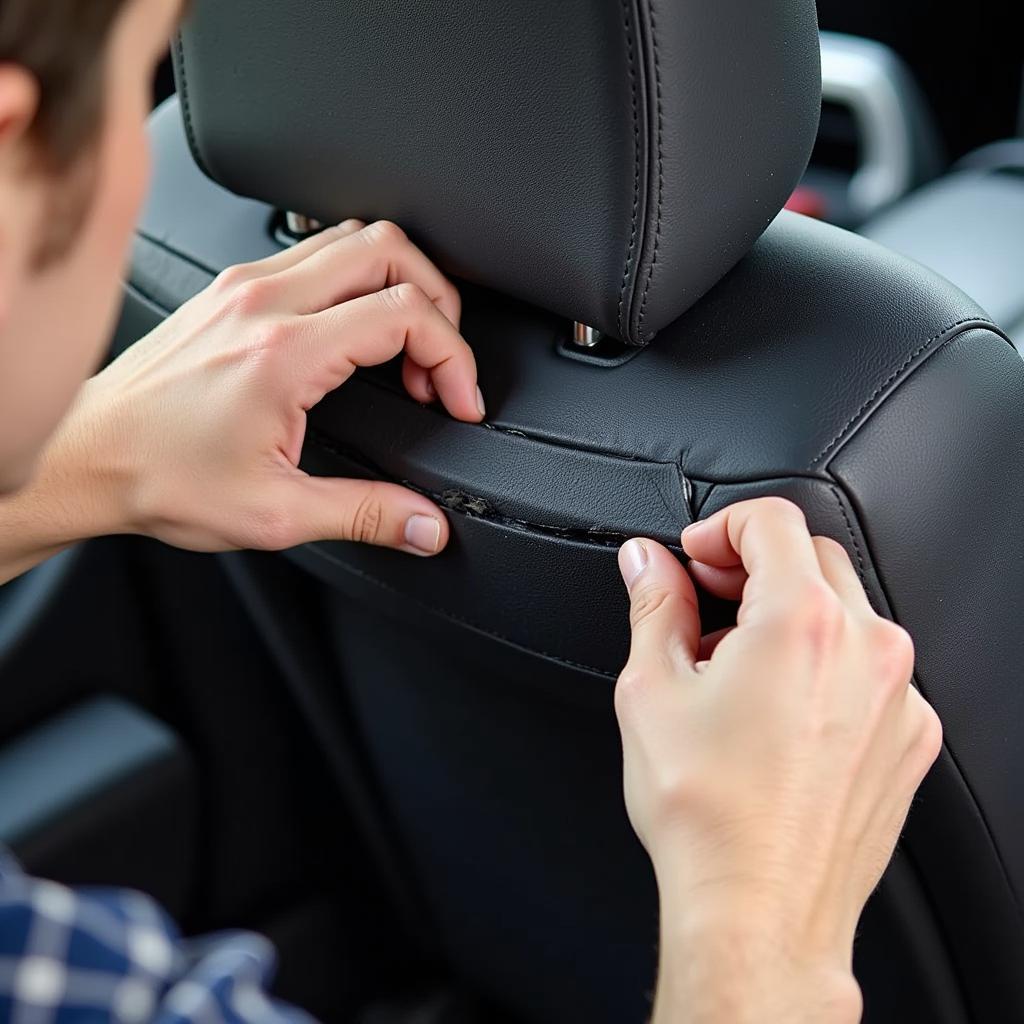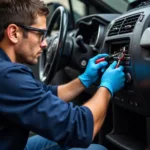Sewing car seat repair offers a cost-effective way to restore your vehicle’s interior. Whether you’re dealing with a small tear, worn-out stitching, or a larger rip, knowing how to sew car seat repairs can save you money and extend the life of your seats. This guide provides a comprehensive overview of the process, from assessing the damage to achieving professional-looking results.
Knowing how to undertake car seat repair yourself can be a valuable skill. Just after this introduction, we’ll delve into the necessary tools and materials you’ll need for a successful car seat repair. Later, we’ll cover various stitching techniques and best practices for different types of car seat materials. how to repair car seat stitching provides another valuable resource for fixing those pesky stitching issues.
Assessing the Damage and Gathering Your Supplies
Before you begin your sewing car seat repair, carefully examine the damaged area. Determine the extent of the tear or wear and the type of material your car seat is made of (leather, vinyl, cloth). This will help you choose the right repair method and materials.
Next, gather your supplies. You’ll need a heavy-duty needle designed for upholstery, strong thread that matches your car seat’s color, a seam ripper (if needed), scissors, and upholstery adhesive (optional). For leather repair, a leather repair kit might be beneficial.
Choosing the Right Thread and Needle
Selecting the correct thread and needle is crucial for a successful sewing car seat repair. Use heavy-duty upholstery thread, as it’s designed to withstand wear and tear. Match the thread color to your car seat for a seamless repair. The needle should be a heavy-duty curved or straight needle, depending on the repair and your preference. Curved needles are often helpful for working in tight spaces.
For more information on repairing torn car seats, check out how to repair a torn car seat.
Sewing Techniques for Car Seat Repair
Several sewing techniques can be used for car seat repair, depending on the type of damage. For small tears, a simple straight stitch might suffice. For larger rips or worn seams, a saddle stitch or baseball stitch offers greater strength and durability. If you’re repairing a tear in leather, consider using a leather sewing machine or taking it to a professional for the best results.
Repairing Leather Car Seats
Leather car seats require special attention. Before sewing, clean the leather thoroughly with a leather cleaner. Use a leather needle and thread specifically designed for leather. For small cracks or scratches, a leather filler can be used before sewing. Consider checking car leather seat repair cost stitching for information on professional leather repair costs.
“When repairing leather, always use a leather-specific needle and thread. This will prevent further damage and ensure a long-lasting repair,” advises John Smith, Master Upholsterer at Smith’s Auto Upholstery.
Repairing Cloth Car Seats
Cloth car seats are generally easier to repair than leather. Use a heavy-duty needle and upholstery thread. For small tears, a simple straight stitch will often suffice. For larger rips, consider patching the area with a matching fabric before sewing. For guidance on repairing or replacing car seat covers, visit how to repair car seat cover.
Repairing Vinyl Car Seats
Vinyl car seats can be repaired with vinyl repair kits. These kits typically include a vinyl patch and adhesive. Sewing can also be used to reinforce the repair or to fix tears that don’t require patching.
“Properly prepping the vinyl surface is key to a successful repair. Make sure the area is clean and dry before applying any adhesive or patch,” recommends Maria Garcia, Senior Automotive Technician at Garcia’s Auto Repair.
Maintaining Your Repaired Car Seats
Once you’ve completed your sewing car seat repair, proper maintenance will help extend the life of your seats. Regularly clean your car seats using a cleaner appropriate for the material. Avoid harsh chemicals that can damage the upholstery. Condition leather seats periodically to keep them supple and prevent cracking. For tips on rejuvenating older car seats, see how to repair old car seats.
Conclusion
Learning how to sewing car seat repair empowers you to address minor damage effectively, saving money and preserving the appearance of your vehicle’s interior. By choosing the right materials and techniques, you can achieve professional-looking results. Remember to always assess the damage carefully, select the appropriate needle and thread, and maintain your repaired seats for long-lasting results.
FAQ
- What type of thread should I use for sewing car seat repair?
- What is the best needle for car seat repair?
- How do I repair a tear in leather car seats?
- Can I repair vinyl car seats myself?
- What’s the best way to maintain my repaired car seats?
- How do I choose the right sewing technique for my car seat repair?
- What are the common mistakes to avoid during car seat repair?
Need Help? Contact us via WhatsApp: +1(641)206-8880, Email: [email protected]. We have a 24/7 customer support team.



